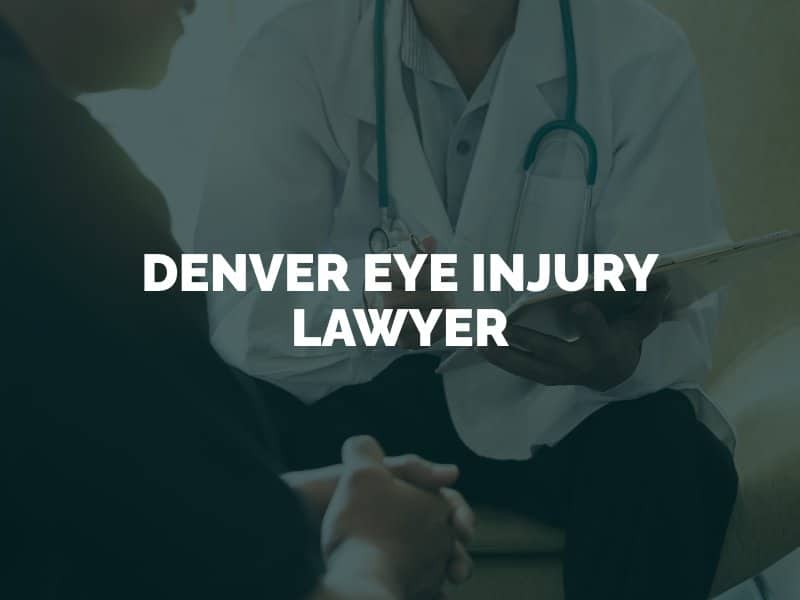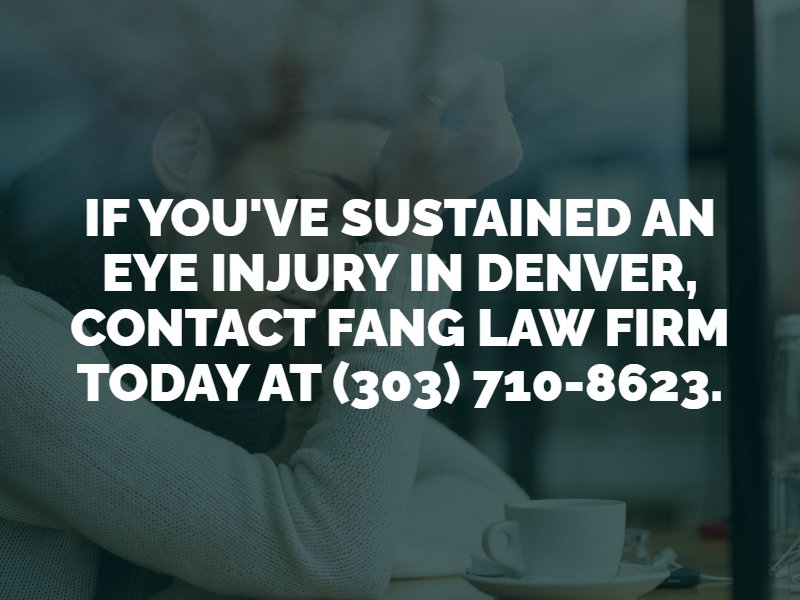If you have suffered eye injury through the negligence of another, contact Fang Accident Lawyers in Denver. Our Denver eye injury lawyer can tell you if you have a case and what damages you may be entitled to claim. The human eye is an organ that is fragile and essential for everyday function. Sadly, thousands of eye injuries occur every year in the workplace alone.

After an accident causing eye injuries, the responsible party’s insurance company may try to deny liability or reduce the amount of your claim. Insurance companies are for-profit corporations motivated to reduce their payouts and increase profits for shareholders. You may be offered a settlement that does not cover the damages you have suffered. An experienced Denver eye injury attorney can help pursue the damages you deserve after an accident.
An eye injury lawyer can conduct a thorough investigation of the accident that injured you to search for signs and evidence of negligence. This may involve interviewing eyewitnesses, gathering documents and records, hiring highly qualified experts, and re-creating the accident. Then, your lawyer can present your case to an insurance company (or judge or jury during a personal injury trial) in a compelling way.
An attorney in Denver can utilize proven and aggressive legal strategies to negotiate a fair settlement value from an insurer on your behalf. Meanwhile, you will enjoy greater mental peace to focus on healing from your injuries and rebuilding your life. You will not have to worry about taking on complicated legal processes or succumbing to an insurance company’s attempts to take advantage of you with a lawyer by your side.
The eye is a complex organ that may suffer a variety of injuries in a traumatic accident. Many different parts of the eye can sustain damage, potentially causing levels of vision impairment or loss. Every type of eye injury requires immediate medical care for proper treatment.
Types of eye injuries include:
Many eye injuries have the potential to cause temporary or permanent vision loss. There are many different types of vision loss, including blurred vision, blind spots, light sensitivity, loss of peripheral vision and blindness. Loss of vision can have a major impact on an accident victim’s daily life.
The tissues of the eye are delicate and susceptible to injury. Common causes of eye injuries include:
If someone else’s negligence or failure to use proper care caused your eye injury, you may be eligible for financial compensation in Denver.
Motor vehicle crashes are a leading cause of eye injuries in the U.S. Auto accidents present unique eye injury risk factors, including:
In a study published by the National Institutes of Health in 2014, researchers found the following facts about eye injuries caused by motor vehicle accidents:
If you suffered an injury to your eye due to negligence in a car accident, our auto collision lawyers in Denver can help.
An eye injury that affects vision can permanently alter a victim’s life. This is what is known as a catastrophic injury in personal injury law. A serious eye injury could result in many life-altering consequences, including:
Eye injuries can cause vision impairment, blindness, pain, discomfort, decreased functionality, a financial burden and mental health disorders. Physical and mental health support services can be crucial to help victims cope with the consequences of eye injuries.
In Colorado, an accident victim who suffers an eye injury can pursue justice from the person or party that caused the injury through the civil legal system. A personal injury claim can hold an at-fault party accountable for his or her actions and result in financial compensation for the victim’s related losses.
Liability for eye injuries depends on what caused the accident and the surrounding circumstances. The at-fault driver may be liable if eye injuries are sustained in a motor vehicle accident. In a product liability claim, the manufacturer of the defective item can be named as the defendant. If your eye injuries were caused by someone else’s negligence, our experienced Denver eye injury lawyers can investigate the accident to determine liability.
Holding someone liable for an eye injury typically involves filing an insurance claim and negotiating a settlement that resolves the legal dispute. In some cases, eye injury claims need to proceed to court. In a workplace accident eye injury case, a workers’ compensation claim may be available. This is a type of no-fault insurance claim for eligible employees who get injured within the course and scope of employment in Colorado.

The goal of a personal injury case is to make a victim whole again through a monetary award that is given to reimburse the claimant’s losses. A successful eye injury case in Denver can help a victim move forward by awarding the financial compensation (also known as damages) he or she needs to pay for related costs.
Available damages in an eye injury claim may include:
You and your family could seek compensation for a variety of economic and noneconomic losses through a Denver eye injury claim. Our attorneys at Fang Accident Lawyers are prepared to help you fight for maximum financial compensation for your present costs as well as future estimated losses. Contact us to discuss the potential value of your eye injury case.
A statute of limitations is a law that places a time limit on the ability to file a lawsuit. Colorado Revised Statutes (CRS) Section 13-80-102 states: The following civil actions, regardless of the theory upon which suit is brought, or against whom suit is brought, must be commenced within two years after the cause of action accrues, and not thereafter: (a) Tort actions, including but not limited to actions for negligence, trespass, malicious abuse of process, malicious prosecution, outrageous conduct, interference with relationships, and tortious breach of contract.”
According to this law, most eye injury claims must be filed within two years of the date of injury or discovery of injury. However, Colorado has an exception for injuries caused by car accidents. CRS 13-80-101(n)(I) states: “All tort actions for bodily injury or property damage arising out of the use or operation of a motor vehicle…shall be commenced within three years after the cause of action accrues, and not thereafter.”
Note that these are the time limits for eye injury lawsuits, not insurance claims. Insurance claims should be started much sooner – typically, within 24 to 72 hours of the incident. Certain circumstances may lengthen or shorten the filing window. For instance, under the Colorado Governmental Immunity Act, administrative claims against the government must be filed within no more than 182 days of the date of injury.
Finally, if the eye injury victim is a minor under the age of 18, he or she generally has two years from the date of his or her 18th birthday to file a claim in Colorado. With limited exceptions, claims that are filed after the statute of limitations has expired will be time-barred, meaning the claimant will not be allowed to proceed. It is important to contact a Denver eye injury lawyer as soon as possible to discuss a potential case.
Our Denver trial lawyers at Fang Accident Lawyers can provide sound legal counsel and negotiate with insurance companies on your behalf. Contact us as soon as possible if you have sustained eye injuries in an accident that was someone else’s fault.